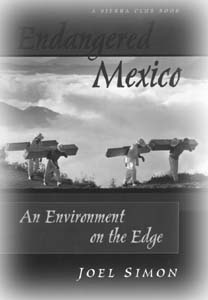![[Metroactive Books]](/books/gifs/books468.gif)
![[Metroactive Books]](/books/gifs/books468.gif)
[ Books Index | Metro | Metroactive Central | Archives ]
Bordering on Disaster
 Facing Grim Reality: The United States, says author Joel Simon, cannot afford to turn its back on the ecological crises that threaten to overwhelm Mexico.
The environmental crisis in Mexico does not stop at our political boundary By Christopher Weir 'THEY DON'T treat people like this in San Diego or El Segundo," says a border-town activist in Joel Simon's Endangered Mexico. "Well, we are human beings too." These human beings, Simon reveals, are the losers in Mexico's dangerous game of environmental roulette. Forced from their native landscapes by desiccated farmlands, cultural disintegration and entrenched ecological mismanagement, many find themselves working in American-owned border factories, earning 55 cents an hour and living in shantytowns haunted by their employer's toxic detritus. Is it any wonder, Simon asks, that these human beings should cross the border to seek a better life brokered by agricultural and industrial fat cats gunning for cheap, illegal labor? Still, Endangered Mexico is not about placing blame but rather about facing grim realities. From the jungles of southern Mexico to the slopes of the Sierra Madre, from the sun-addled shores of Cancun to the acrid industrialism hedging the U.S. border, Endangered Mexico deftly navigates a land on the brink of ecological implosion and illustrates how the foreshocks already impact the United States. After taking perhaps a few too many pages to establish his tenor and momentum, Simon strikes an engaging counterpoint between anecdotal testimonies and studied analysis. The author walks beside poisoned rivers, trudges through embattled wilderness and ultimately infuses his reporting with vitality and curiosity. To his credit, he never pretends to be an insider. But he's no glass-tower outsider, either. It is in this middle ground that Endangered Mexico weaves a tapestry of true compassion, brutal honesty and rock-solid research. Simon is especially adept at enhancing his detached narrative with first-person adventures, some of which reveal flashes of self-discovery that illuminate a broader cultural canvas. For example, while camping with some locals in the drug-infested Sierra Madre range, he finds himself throwing a rock at some stray mutt that is nosing around their cookout. "What had happened to me?" Simon asks. "At first, I did not like that image of myself, but then it occurred to me that this was a less romantic function of the wilderness--not solace, but freedom to break the rules. ... If I had let on that I normally did not approve of pelting dogs with rocks, my companions would have been either baffled or amused." STRANGELY, Simon's otherwise comprehensive work sidesteps a central question that will subliminally taunt readers throughout the book: What role does population growth play in Mexico's environmental conundrums? After all, repeated references are made to large families that must slash-and-burn their way to sustenance, and at one point, "siring" children is presented as an aspect of regional machismo. Yet only near the very last page does Simon really engage the population dynamic, and even then he quickly dismisses it as relatively insignificant. If Mexico's population explosion--from 25 million people in 1945 to more than 90 million today--is indeed a comparatively minor factor within the context of the country's general environmental mismanagement, then Simon should have proved that point much earlier--and with more compelling discussion about the cultural, religious, practical or medical forces behind Mexico's population trends. At times, Simon's journalistic pacing leads to confused storytelling. The poisonous miasma that engulfs Mexico City in the opening paragraph, the petroleum plant explosion that sends aromas of "gas and burned flesh" through Mexico City's San Juanico neighborhood, the surreal slumber party with Zapatista subcommander Marcos--these are all linchpin moments that Simon conjures forcefully but drops too quickly and without adequate development. Nevertheless, it is Simon's journalistic prowess that makes Endangered Mexico such an insightful, incisive and instructive exposé. His reporting is balanced, but not to the point of indecision or spinelessness. His sympathies and passions never descend into illogic, and he is honest about the cultural and socioeconomic currents to which Mexico's ecological emergencies are wired. Endangered Mexico ultimately dismantles our collective assumptions about Mexico to reveal a world teeming with complexities, riddles and contradictions, a world in which increased border patrols and free-trade agreements are mere fingers in the bursting dikes of economic chaos and ecological bankruptcy. If the United States wants to develop effective immigration and trade policies with regard to Mexico, Simon argues, then it must eventually confront the tough questions posed by Mexico's number-one problem: environmental dysfunction. "The border is too vast and the migrants too determined for enforcement to have more than a limited effect," Simon writes. "The integration between the developed and developing world is not unique to the United States and Mexico. It is part of a global trend. That is why the United States needs to take a greater interest in Mexico's environmental crisis." He also identifies political corruption, deception and inequity as the root of this crisis and advocates long-overdue reform within the Mexican system. Because while it may be nearing midnight in the once-fertile garden of Mexico, it's not too late to turn back the clock. "Nature, like hope," writes Simon, "does not die so easily."
Endangered Mexico: An Environment on the Edge by Joel Simon; Sierra Club Books; 262 pages; $27 cloth. [ Metro | Metroactive Central | Archives ]
| ||||||||||||||||||||||||||||||
This page was designed and created by the Boulevards team.
Copyright © 1997 Metro Publishing, Inc.